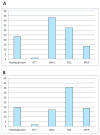Tests and expenditures in the initial evaluation of peripheral neuropathy
- PMID: 22271119
- PMCID: PMC3694340
- DOI: 10.1001/archinternmed.2011.1032
Tests and expenditures in the initial evaluation of peripheral neuropathy
Abstract
Background: Peripheral neuropathy is a common disorder in which an extensive evaluation is often unrevealing.
Methods: We sought to define diagnostic practice patterns as an early step in identifying opportunities to improve efficiency of care. The 1996-2007 Health and Retirement Study Medicare claims-linked database was used to identify individuals with an incident diagnosis of peripheral neuropathy using International Classification of Diseases, Ninth Revision, codes and required no previous neuropathy diagnosis during the preceding 30 months. Focusing on 15 relevant tests, we examined the number and patterns of tests and specific test utilization 6 months before and after the incident neuropathy diagnosis. Medicare expenditures were assessed during the baseline, diagnostic, and follow-up periods.
Results: Of the 12, 673 patients, 1031 (8.1%) received a new International Classification of Diseases, Ninth Revision, diagnosis of neuropathy and met the study inclusion criteria. Of the 15 tests considered, a median of 4 (interquartile range, 2-5) tests were performed, with more than 400 patterns of testing. Magnetic resonance imaging of the brain or spine was ordered in 23.2% of patients, whereas a glucose tolerance test was rarely obtained (1.0%). Mean Medicare expenditures were significantly higher in the diagnostic period than in the baseline period ($14,362 vs $8067, P < .001).
Conclusions: Patients diagnosed as having peripheral neuropathy typically undergo many tests, but testing patterns are highly variable. Almost one-quarter of patients receiving neuropathy diagnoses undergo high-cost, low-yield magnetic resonance imaging, whereas few receive low-cost, high-yield glucose tolerance tests. Expenditures increase substantially in the diagnostic period. More research is needed to define effective and efficient strategies for the diagnostic evaluation of peripheral neuropathy.
Conflict of interest statement
Funding/support: Drs. Callaghan and Feldman are supported by a NIH T32 grant, the Katherine Rayner Program, and by the Taubman Medical Institute. The Health and Retirement Study is supported by the National Institute on Aging (U01 AG09740), and performed at the Institute for Social Research, University of Michigan. Dr. Langa is supported by National Institute on Aging grant R01 AG030155. Dr. Kerber is supported by NIH/NCRR #K23 RR024009 and AHRQ #R18 HS017690. Dr. Kerber also received speaker honoraria from the American Academy of Neurology 2010 and 2011 annual meeting, and performed consulting work for the American Academy of Neurology.
Figures



Comment in
-
Diagnosis of neuropathy: comment on "tests and expenditures in the initial evaluation of peripheral neuropathy".Arch Intern Med. 2012 Jan 23;172(2):132-3. doi: 10.1001/archinternmed.2011.1718. Arch Intern Med. 2012. PMID: 22271120 No abstract available.
Similar articles
-
Diagnosis of neuropathy: comment on "tests and expenditures in the initial evaluation of peripheral neuropathy".Arch Intern Med. 2012 Jan 23;172(2):132-3. doi: 10.1001/archinternmed.2011.1718. Arch Intern Med. 2012. PMID: 22271120 No abstract available.
-
The diagnostic yield of a standardized approach to idiopathic sensory-predominant neuropathy.Arch Intern Med. 2004 May 10;164(9):1021-5. doi: 10.1001/archinte.164.9.1021. Arch Intern Med. 2004. PMID: 15136313
-
Longitudinal patient-oriented outcomes in neuropathy: Importance of early detection and falls.Neurology. 2015 Jul 7;85(1):71-9. doi: 10.1212/WNL.0000000000001714. Epub 2015 May 27. Neurology. 2015. PMID: 26019191 Free PMC article.
-
Laboratory testing in peripheral nerve disease.Neurol Clin. 1996 Feb;14(1):119-33. doi: 10.1016/s0733-8619(05)70246-2. Neurol Clin. 1996. PMID: 8676840 Review.
-
[Diagnosis of peripheral neuropathy in lead workers].Sangyo Igaku. 1984 Jan;26(1):3-8. Sangyo Igaku. 1984. PMID: 6090741 Review. Japanese.
Cited by
-
Impairments and comorbidities of polyneuropathy revealed by population-based analyses.Neurology. 2015 Apr 21;84(16):1644-51. doi: 10.1212/WNL.0000000000001492. Epub 2015 Apr 1. Neurology. 2015. PMID: 25832668 Free PMC article.
-
Target-enrichment sequencing and copy number evaluation in inherited polyneuropathy.Neurology. 2016 May 10;86(19):1762-71. doi: 10.1212/WNL.0000000000002659. Epub 2016 Apr 13. Neurology. 2016. PMID: 27164712 Free PMC article.
-
Knowledge gaps in diagnosing chronic polyneuropathy: Review of national guidelines.J Peripher Nerv Syst. 2024 Dec;29(4):383-392. doi: 10.1111/jns.12667. Epub 2024 Oct 29. J Peripher Nerv Syst. 2024. PMID: 39473054 Free PMC article. Review.
-
Exome Sequencing and Gene Prioritization Correct Misdiagnosis in a Chinese Kindred with Familial Amyloid Polyneuropathy.Sci Rep. 2016 May 23;6:26362. doi: 10.1038/srep26362. Sci Rep. 2016. PMID: 27212199 Free PMC article.
-
Distal Symmetric Polyneuropathy: A Review.JAMA. 2015 Nov 24;314(20):2172-81. doi: 10.1001/jama.2015.13611. JAMA. 2015. PMID: 26599185 Free PMC article. Review.
References
-
- Bharucha NE, Bharucha AE, Bharucha EP. Prevalence of peripheral neuropathy in the Parsi community of Bombay. Neurology. 1991 Aug;41(8):1315–1317. - PubMed
-
- Savettieri G, Rocca WA, Salemi G, et al. Prevalence of diabetic neuropathy with somatic symptoms: a door-to-door survey in two Sicilian municipalities. Sicilian Neuro-Epidemiologic Study (SNES) Group. Neurology. 1993 Jun;43(6):1115–1120. - PubMed
-
- Gregg EW, Sorlie P, Paulose-Ram R, et al. Prevalence of lower-extremity disease in the US adult population >=40 years of age with and without diabetes: 1999–2000 national health and nutrition examination survey. Diabetes Care. 2004 Jul;27(7):1591–1597. - PubMed
-
- England JD, Gronseth GS, Franklin G, et al. Practice Parameter: evaluation of distal symmetric polyneuropathy: role of laboratory and genetic testing (an evidence-based review). Report of the American Academy of Neurology, American Association of Neuromuscular and Electrodiagnostic Medicine, and American Academy of Physical Medicine and Rehabilitation. Neurology. 2009 Jan 13;72(2):185–192. - PubMed
-
- Smith AG, Singleton JR. The diagnostic yield of a standardized approach to idiopathic sensory-predominant neuropathy. Arch Intern Med. 2004 May 10;164(9):1021–1025. - PubMed
Publication types
MeSH terms
Substances
Grants and funding
LinkOut - more resources
Full Text Sources
Other Literature Sources
Medical
Miscellaneous

